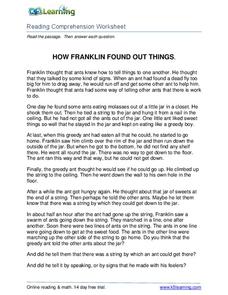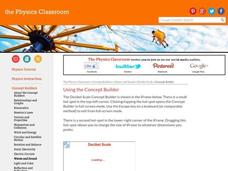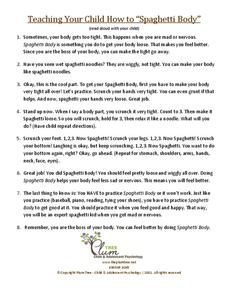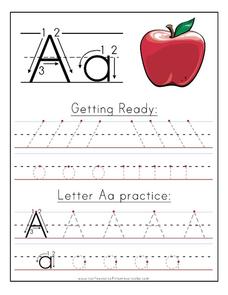K5 Learning
How Franklin Found Out Things
Franklin learns about the world by making observations, and so do we! A short reading assignment prompts fourth graders to answer comprehension questions about a curious boy and what he notices.
Jamestown-Yorktown Foundation
Making a Patriot Inquiry: Are Independence, Freedom, and Liberty the Same Thing?
As part of a study of the American Revolution, class members engage in an inquiry-based lesson that has them watch a scene from the play Slave Spy, examine multiple primary source documents, and then discuss the similarities and...
Flagstaff Arts & Leadership Academy
PowerPoint Project “All About Me”
Get to know each individual while implementing technology practice and use. Each pupil creates a presentation about him or herself that follows a concrete list of requirements. While presenting, the instructor and peers rank the...
Curated OER
Sorting Things Out
Written to examine seeds that grow in Kansas, you can adapt this lesson to anywhere you live. Learners sort a mixture of five different seeds to by any characteristic of their choice. When your budding scientists are exploring the life...
Curated OER
How Did Different People Live in Ancient Egyptian Times
What was life like for ancient Egyptians? Well, that depends on a person's job or title. Find out what life was like for pharaohs, priests, scribes, peasants, nobles, and craftsmen in Ancient Egypt. Each slide contains an image and a...
Environment Agency - Abu Dhabi
Find the Most Spectacular Volcanoes in the World!
Heat things up in your earth science class with this collaborative lesson on volcanoes. After first being introduced to the different types of volcanoes and how they are formed, young geologists work in small groups to research the...
Physics Classroom
Decibel Scale
Turn it up! Sound scientists explore the decibel scale through an interactive that calculates movement up and down the scale. Part of a series of interactives that explore sounds and waves, the resource includes a help feature to support...
Center for History Education
How Did the Public View Women’s Contributions to the Revolutionary War Effort?
Calling upon the legacies of Joan of Arc, Elizabeth I, and Catherine the Great, Esther Reed rallied Southern women to support the American Revolution. Using a broadside by Reed and other primary sources, such as poetry, young historians...
Plum Tree
Teaching Your Child How to "Deep Breathe"
Feeling stressed, angry, or nervous? It's time to practice the exercise detailed in Deep Breathe to breathe your cares away. The activity brings the focus back to one's self and identifies the importance of staying calm.
Plum Tree
Teaching Your Child How to "Spaghetti Body"
We all feel stressed at times, but we don't have to feel that way for long by practicing a coping skill called, Spaghetti Body. When a high stakes test or presentation is on its way, follow the instructions on this resource to begin the...
Plum Tree
Teaching Your Child How to “Stress Press”
Are you or your scholars feeling stressed? Use the coping skill resource, Stress Press, to relieve the feeling that may be growing inside you when a big test or presentation is on its way.
Confessions of a Homeschooler
A-Z Handwriting
Get your youngsters ready to write letters with a whole alphabet of practice pages! Each page includes an uppercase and a lowercase letter (each labeled with arrows to show how to draw the letters), an image of an animal or thing that...
Scholasic
The Magic School Bus and the Missing Tooth
We chew with our teeth every day, but how much do we really know about them? Allow Ms. Frizzle to teach your kids a thing or two about teeth. Kids complete a prereading exercise, read the book, and respond to several prompts about the...
Royal Society of Chemistry
Apparatus Diagrams 2
Ready to heat things up in the lab, but your class doesn't know its way around a Bunsen burner? Scholars get familiar with heating apparatuses through a series of puzzles designed to promote vocabulary and reasoning skills. The activity...
EngageNY
Grade 10 ELA Module 2: Unit 2, Lesson 10
All good things must come to an end! Scholars put all their learning into practice by completing an end-of-unit assessment. They use textual evidence from Julia Alvarez's "A Genetics of Justice" to write essays analyzing how Alvarez...
EngageNY
Grade 10 ELA Module 4: Unit 2, Lesson 2
What is the best way to determine the theme of a text? Pupils analyze how central ideas emerge in Shakespeare's tragedy Macbeth. They work in small groups and engage in a whole-class discussion to discuss the play's plot. Finally,...
EngageNY
Analyzing an Author’s Craft: Carlotta’s Journey to Justice
What's an appropriate response? Scholars open the text A Mighty Long Way to see how Carlotta responded to racism, discrimination, and abuse. They work in pairs to answer questions regarding her responses. To finish, they use the Dignity...
EngageNY
Mid-Unit Assessment: Evidence, Ideas, and Interactions in “Why Couldn’t Snow White Be Chinese?”
The class is halfway there! Pupils complete a mid-unit assessment by answering questions in Evidence, Ideas, and Interactions in Why Couldn’t Snow White Be Chinese? Readers then work with partners to analyze the 2010 Census: United...
Health Smart Virginia
Parachute Stress
Stress isn't necessarily a bad thing. The key, however, is learning how to appreciate eustress and manage distress. "Parachute Stress," a lesson designed for high school freshmen, has them identify 10 major stressors as well as the...
Curated OER
Simple Machine Test
Students complete several worksheets about machines. In this machine lesson students complete several handouts that describe the different machines and how pulleys work.
Curated OER
Habitat
Learners are able to define habitat. They are able to identify the four things that living things need to survive. Students are able to describe how living things are adapted to their habitats.
Curated OER
The Works Progress Administration and the New Deal
Learners research the Depression Era and how it contributed to the formation of the Works Progress Administration. After research, they create a skit to illustrate life during the Depression and the role of the Works Progress...
Curated OER
Micro-organisms
Students learn what a micro-organism is. In this micro-organism lesson plan, students understand that micro-organisms may be too small to see. Students learn microorganisms could be bacteria, fungi, something beneficial or a harmful...
Curated OER
Simple Machines
First graders discuss work, force, and energy. They study how work is done. Students discuss various types of work that are done. They act out how work is done. Student draw pictures of types of work they have done.
Other popular searches
- How Things Work Lenses
- How Things Work Toaster
- Explaining How Things Work
- How Things Work" Odometer
- Explanation How Do Things Work
- How Things Work Odometer
- "How Things Work" Odometer

























